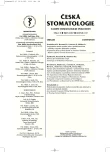Anchorage in Orthodontic Treatment
Authors:
M. Špidlen; M. Kamínek; M. Halířová
Authors‘ workplace:
Klinika zubního lékařství LF UP a FN, Olomouc
přednosta prof. MUDr. M. Eber, CSc.
Published in:
Česká stomatologie / Praktické zubní lékařství, ročník 107, 2007, 5, s. 117-122
Overview
The change in position and relationship of first permanent molars as well as the change in relationship and in axial position of upper and lower incisors in orthodontic therapy with extractions was measured.
The sample comprised 55 patients; 28 patients were treated with extraction of two upper premolars, 27 patients were treated with extraction of four premolars – two in the maxilla and two in the mandible. The mesial movement of molars was present which was planned in many cases, however, in treatment without extractions in lower arch also the unplanned mesial movement of lower molars was found. In 8 of 28 patients without extraction in lower arch the lower incisors moved more than 2 mm in labial direction.
The change in axial position of incisors was significant only in the sample of patients with extraction of four premolars. Interincisal angle increased by 11.18°, apex of the upper central incisor moved in labial direction by 1.02 mm (with regard to NB line). In the sample with extraction of two maxillary premolars there were no statistically significant changes in the axial position of incisors.
Key words:
anchorage in orthodontics - relation of molars - relation and position of incisors
Labels
Maxillofacial surgery Orthodontics Dental medicineArticle was published in
Czech Dental Journal

2007 Issue 5
Most read in this issue
- Non-surgical Treatment of a Tooth Associated with a Large Periapical Radiolucency Resembling Periapical Cyst
- Anatomical Deviations of Endodontium as a Cause of Failure of Endodontic Treatment
- Anchorage in Orthodontic Treatment
- Corrosion of Dental Alloys
